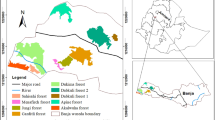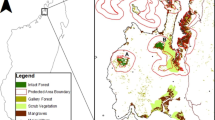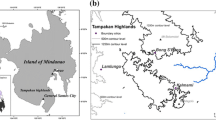Abstract
This study was conducted in the Chiapas Highlands, a tropical mountain region where traditional agricultural practices have resulted in a mosaic landscape of forest fragments embedded in a matrix of secondary vegetation and crop fields. The question addressed was how may woody species richness be affected by forest fragment attributes derived from traditional land-use patterns. Species inventories of total woody species, canopy and understorey trees, and shrubs were obtained in 22 forest fragments (≥5 ha). Multiple regression analyses were applied to examine the effects of size, matrix, isolation and shape of the forest fragments on richness of these species guilds. Fragment size was correlated with shape (r = 0.75) and isolation (r = −0.69), and isolation was correlated with shape (r = −0.75). Total species richness, and number of shrubs and understorey trees in fragments were related to isolation; moreover, additive effects of fragment shape were found for shrubs. The number of canopy species was not related to any fragment variable. Matrix did not help to explain species richness, possibly due to the landscape structure created by the traditional land-use patterns. In addition to size and isolation, we point out the need of considering shape and matrix as additional fragmentation attributes, along with social and economic factors, if we are ever going to be successful in our management and conservation actions.
Similar content being viewed by others
References
Anonymous 1999. SPSS Advanced Statistics™ 10.0. SPSS Inc., Chicago, Illinois.
Bierregaard R.O. Jr. and Dale V.H. 1993. Island in an ever-changing sea: the dynamics of Amazonian rain forest fragments. In: Doyle J.K. and Schelhas J. (eds), Proceedings of the Symposium Forest Remnants in the Tropical Landscape: Benefits and Policy Implications. 10-11 September 1992. Smithsonian Institution, Washington, DC, pp. 8–10.
Bierregaard R.O. Jr., Lovejoy T.E., Kapos V., dos Santos A.A. and Hutchings R.W. 1992. The biological dynamics of tropical rainforest fragments. BioScience 42: 859–866.
Breedlove D.E. 1981. Flora of Chiapas. Part I: Introduction to the Flora of Chiapas. California Academy of Sciences, San Francisco, California.
Buckley R.C. 1985. Distinguishing the effects of area and habitat type on island plant species richness by separating floristic elements and substrate types and controlling for island isolation. Journal of Biogeography 12: 527–535.
De Boer A.J. 1989. Sustainable approaches to hillside agricultural development. In: Leonard J.H., Yudelman M., Strycker J.D., Browder J.O., de Boer A.J., Campbell T. et al. (eds), Environment and Poor: Development Strategies for a Common Agenda. Transaction Books, New Brunswick, New Jersey, pp. 111–133.
DETENAL 1980.Mapa de Clima, Escala 1:250000, hoja E15-11. Dirección de Estudios del Territorio Nacional, México, Distrito Federal, Mexico.
Dunning J.B. Jr., Borgella R. Jr., Clements K. and Meffe G.K. 1995. Patch isolation, corridor effects and colonization by a resident sparrow in a managed pine woodland. Conservation Biology 9: 542–549.
Dzwonko Z. 1993. Relations between the floristic composition of isolated young woods and their proximity to ancient woodland. Journal of Vegetation Science 4: 693–698.
Fahrig L. and Merriam G. 1995. Habitat patch connectivity and population survival. Ecology 66: 1762–1768.
Frelich L.E. and Reich P.B. 1998. Disturbance severity and threshold responses in the boreal forest. Conservation Ecology, http://www.consecol.org/vol2/iss2/art7.
Galindo-Jaimes L., González-Espinosa M., Quintana-Ascencio P. and García-Barrios L. 2002. Tree composition and structure in disturbed stands with varying dominance by Pinus spp. in the highlands of Chiapas, Mexico. Plant Ecology 162: 259–272.
Gibson J.D., Collins S.L. and Good R.E. 1988. Ecosystem fragmentation of oak–pine forest in the New Jersey pineland. Forest Ecology and Management 25: 105–122.
González-Espinosa M., Ochoa-Gaona S., Ramírez-Marcial N. and Quintana-Ascencio P.F. 1995. Current land-use trends and conservation of old-growth forest habitats in the highlands of Chiapas, Mexico. In: Wilson M. and Sader S. (eds), Neotropical Migratory Birds in Mexico. Maine Agricultural and Forest Experimental Station, Orono, Maine, pp. 190–198.
González-Espinosa M., Ochoa-Gaona S., Ramírez-Marcial N. and Quintana-Ascencio P.F. 1997. Contexto vegetacional y florístico de la agricultura en Los Altos de Chiapas, México. In: Parra-Vázquez M.R. and Díaz-Hernández B.M. (eds), Los Altos de Chiapas: Agricultura y Crisis Rural. Tomo I. Los Recursos Naturales. El Colegio de la Frontera Sur, San Cristóbal de Las Casas, Chiapas, Mexico, pp. 85–117.
Hamazaki T. 1996. Effects of patch shape on the number of organisms. Landscape Ecology 11: 299–306.
Hanski I. 1994. Spatial scale, patchiness and population dynamics on land. Philosophical Transactions of the Royal Society of London 343: 19–25.
Higgs A.J. 1981. Island biogeographic theory and nature reserve design. Journal of Biogeography 8:117–124.
Honnay O., Hermy M. and Coppin P. 1999 Effect of area, age and diversity of forest patches in Belgium on plant species richness, and implications for conservation and reforestation. Biological Conservation 87: 73–84.
Iida S. and Nakashizuka T. 1995. Forest fragmentation and its effect on species diversity in sub-urban coppice forest in Japan. Forest Ecology and Management 73: 197–210.
INEGI 1984 Carta Topográfica escala: 1:50000, hojas E15D52, E15D62 y E15D63. Instituto Nacional de Estadística, Geografía e Informática, México, Distrito Federal, Mexico.
INEGI 1985. Carta Edafológica escala: 1:250000, hoja E15-11. Instituto Nacional de Estadística, Geografía e Informática, México, Distrito Federal, Mexico.
Kadmon R. and Pulliam H.R. 1993. Island biogeography: effect of geographical isolation on species composition. Ecology 74: 977–981.
Kapos V. 1989. Effects of isolation on the water status of forest patches in the Brazilian Amazon. Journal of Tropical Ecology 5: 173–185.
Kellman M., Tackaberry R. and Meave J. 1996. The consequences of prolonged fragmentation: lessons from tropical gallery forests. In: Schelhas J. and Greenber R. (eds), Forest Patches in Tropical Landscapes. Island Press, Washington, DC, pp. 37–58.
Lamprecht H. 1990. Silvicultura en los Trópicos: Los Ecosistemas Forestales en los Bosques Tropicales y sus Especies Arbóreas. Deutsche Gesellschaft für Technische Zusammenarbeit (GTZ), Eschborn, Germany.
Lee T.A. 1994. La antigua historia de las etnias de Chiapas. In: Armendáriz M.L. (ed.), Chiapas: una radiografía. Fondo de Cultura Económica, México, Distrito Federal, Mexico, pp. 55–69.
Lord J.M. and Norton D.A. 1990. Scale and the spatial concept of fragmentation. Conservation Biology 4: 197–202.
Lovejoy T.E., Bierregaard R.O., Rankin J.M. and Schubart H.O.R. 1983. Ecological dynamics of tropical forest fragments. In: Sutton S.L., Whitmore T.C. and Chadwick A.C. (eds), Tropical Rain Forest Ecology and Management. Blackwell Publications, Oxford, UK, pp. 377–384.
Lovejoy T.E., Bierregaard R.O., Rylands A.B., Malcolm J.R., Quintela C.E., Harper L.H. et al. 1986. Edge and other effects on isolation on Amazonian forest fragments. In: Soulé M.E. (ed.), Conservation Biology: the Science of Scarcity and Diversity. Sinauer Associates, Sunderland, Massachusetts, pp. 257–285.
Lowe J.C. and Moryadas S. 1975. The Geography of Movement. Houghton Mifflin, Boston, Massachusetts.
Mac Arthur R.H. and Wilson E.O. 1967. The Theory of Island Biogeography. Princeton University Press, Princeton, New Jersey.
Malcolm J.R. 1991. The small mammals of Amazonian forest fragments: pattern and process. Ph.D. Thesis, University of Florida, Gainesville, Florida.
McGarigal K. and Marks B.J. 1994. FRAGSTATS 2.0, Spatial Pattern Analysis Program for Quantifying Landscape Structure. Oregon State University, Corvallis, Oregon.
Meave J. 1991. Maintenance of tropical rain forest plant diversity in riparian forests of tropical savannas. Ph.D. Thesis, York University, Toronto, Ontario, Canada.
Méndez-Dewar G. 2000. Contrastes espaciales de luz en claros, bordes y hábitats perturbados en Los Altos de Chiapas, México. M.Sc. Thesis, El Colegio de la Frontera Sur, San Cristóbal de Las Casas, Chiapas, Mexico.
Merriam G. and Wegner J. 1992. Local extinctions, habitat fragmentation, and ecotones. In: Hansen A.J. and di Castri F. (eds), Landscapes Boundaries: Consequences for Biotic Diversity and Ecological Flow. Springer-Verlag, New York, pp. 150–169.
Miranda F. 1952. La Vegetación de Chiapas, T I. Gobierno del Estado, Tuxtla Gutiérrez, Chiapas, Mexico.
Montoya-Gómez G. 1998. El Subsector Forestal en Los Altos de Chiapas: Breve Análisis Económico de Largo Plazo. Universidad Autónoma de Chiapas, Tuxtla Gutiérrez, Chiapas, Mexico.
Moss M.R. and Davis L.S. 1994. Measurement of spatial change in the forest component of the rural landscape of southern Ontario. Applied Geography 14: 214–231.
Müllerried F.K.G. 1957. Geología de Chiapas. Publicaciones del Gobierno del Estado, Tuxtla Gutiérrez, Chiapas, Mexico.
Nilsson I.N. and Nilsson S.G. 1982. Turnover of vascular plant species on small islands in Lake Möckeln, South Sweden 1976-1980. Oecologia 53: 128–133.
Ochoa-Gaona S. 2001. Traditional land-use systems and patterns of forest fragmentation in the highlands of Chiapas, Mexico. Environmental Management 27: 571–586.
Ochoa-Gaona S. and González-Espinosa M. 2000. Land use and deforestation in the highlands of Chiapas, Mexico. Applied Geography 20: 17–42.
Opdam P., van Apeldoorn R., Schotman A. and Kalkhoven J. 1993. Population responses to landscape fragmentation. In: Vos C.C. and Opdam P. (eds), Landscape Ecology of a Stressed Environment. Chapman & Hall, New York, pp. 147–177.
Parra-Vázquez M.R. and Mera-Ovando L.M. 1989. La organización social para la producción. In: Parra-Vázquez M.R. (ed.), El Subdesarrollo Agrícola en Los Altos de Chiapas. Universidad Autónoma Chapingo, Chapingo, Estado de México, Mexico, pp. 315–405.
Peterken G.F. and Game M. 1984. Historical factors affecting the number and distribution of vascular plant species in the woodlands of central Lincolnshire. Journal of Ecology 72: 155–182.
Philippi T.E. 1993. Multiple regression: herbivory. In: Scheiner S.M. and Gurevitch J. (eds), Design and Analysis of Ecological Experiments. Chapman & Hall, New York, pp. 183–210.
Pool-Novelo L. 1997. Intensificación de la agricultura tradicional y cambios de uso del suelo. In: Parra-Vázquez M.R. and Díaz-Hernández B.M. (eds), Los Altos de Chiapas: Agricultura y Crisis Rural, Tomo I. Los Recursos Naturales. El Colegio de la Frontera Sur, San Cristóbal de Las Casas, Chiapas, Mexico, pp. 1–22.
Quinn J.F. and Harrison S.P. 1988. Effects of habitat fragmentation and isolation on species richness: evidence from biogeographic patterns. Oecologia 75: 132–140.
Quintana-Ascencio P.F. and González-Espinosa M. 1992. Afinidad fitogeográfica y papel sucesional de la flora leñosa de los bosques de pino-encino de Los Altos de Chiapas, México. Acta Botanica Mexicana 20: 43–57.
Quintana-Ascencio P.F., González-Espinosa M. and Ramírez-Marcial N. 1992. Acorn removal, seedling survivorship and seedling growth of Quercus crispipilis in successional forests of the highlands of Chiapas, Mexico. Bulletin of the Torrey Botanical Club 119: 6–18.
Ramírez-Marcial N., González-Espinosa M. and Quintana-Ascencio P.F. 1992. Banco y lluvia de semillas en comunidades sucesionales de bosques de pino-encino de Los Altos de Chiapas, México. Acta Botanica Mexicana 20: 59–75.
Ramírez-Marcial N., González-Espinosa M. and García-Moya E. 1996. Establecimiento de Pinus spp. y Quercus spp. en matorrales y pastizales de Los Altos de Chiapas, México. Agrociencia 30: 249–257.
Ranta P., Blom T., Niemela J., Joensuu E. and Siitonen M. 1998. The fragmented Atlantic rain forest of Brazil: size, shape and distribution of forest fragments. Biodiversity and Conservation 7: 385–403.
Romero-Nájera I. 2000. Estructura y Condiciones Microambientales en Bosques Perturbados de Los Altos de Chiapas, México. B.Sc. Thesis, Facultad de Ciencias, Universidad Nacional Autónoma de México, México City, Distrito Federal, Mexico.
Rzedowski J. 1978. Vegetación de México. Limusa, México, Distrito Federal, Mexico.
Rzedowski J. 1991. Diversidad y orígenes de la flora fanerogámica de México. Acta Botanica Mexicana 14: 3–21.
Saunders D.A., Hobbs R.J. and Margules C.R. 1991. Biological consequences of ecosystem fragmentation: a review. Conservation Biology 5: 18–32.
Sierra R. 1999. Traditional resource-use systems and tropical deforestation in a multiethnic region in north-west Ecuador. Environmental Conservation 26: 136–145.
Silva-Forsberg M.C. and Fearnside P.M. 1997. Brazilian Amazonian caboclo agriculture: effect of fallow period on maize field. Forest Ecology and Management 97: 283–291.
Snedecor G.W. and CochranW.G. 1989. Statistical Methods. 7th edn. Iowa State University Press, Ames, Iowa.
Sokal R.R. and Rohlf F.J. 1995. Biometry: the Principles and Practice of Statistics in Biological Research. Freeman, New York.
SPP 1980a. Carta de Precipitación Total Anual, escala: 1:1000000, hoja Villahermosa. Secretaría de Programación y Presupuesto, México, Distrito Federal, Mexico.
SPP 1980b. Carta de Temperatura Media Anual, escala: 1:1000000, hoja Villahermosa. Secretaría de Programación y Presupuesto, México, Distrito Federal, Mexico.
Steyermark J.A. 1950. Flora of Guatemala. Ecology 31: 368–372.
Turner I.M. and Corlett R.T. 1996. The conservation value of small, isolated fragments of lowland tropical rain forest. Trends in Ecology and Evolution 11: 330–333.
Weaver M. and Kellman M. 1981. The effects of forest fragmentation on woodlot tree biotas in southern Ontario. Journal of Biogeography 8: 199–210.
Wright S.J. 1985. How isolation affects rates of turnover of species on islands. Oikos 44: 331–340.
Author information
Authors and Affiliations
Corresponding author
Rights and permissions
About this article
Cite this article
Ochoa-Gaona, S., González-Espinosa, M., Meave, J.A. et al. Effect of forest fragmentation on the woody flora of the highlands of Chiapas, Mexico. Biodiversity and Conservation 13, 867–884 (2004). https://doi.org/10.1023/B:BIOC.0000014457.57151.17
Issue Date:
DOI: https://doi.org/10.1023/B:BIOC.0000014457.57151.17




